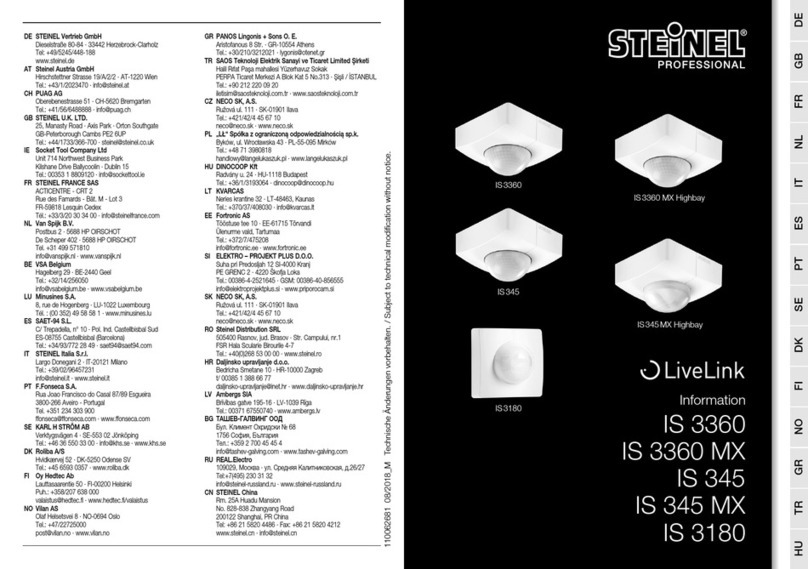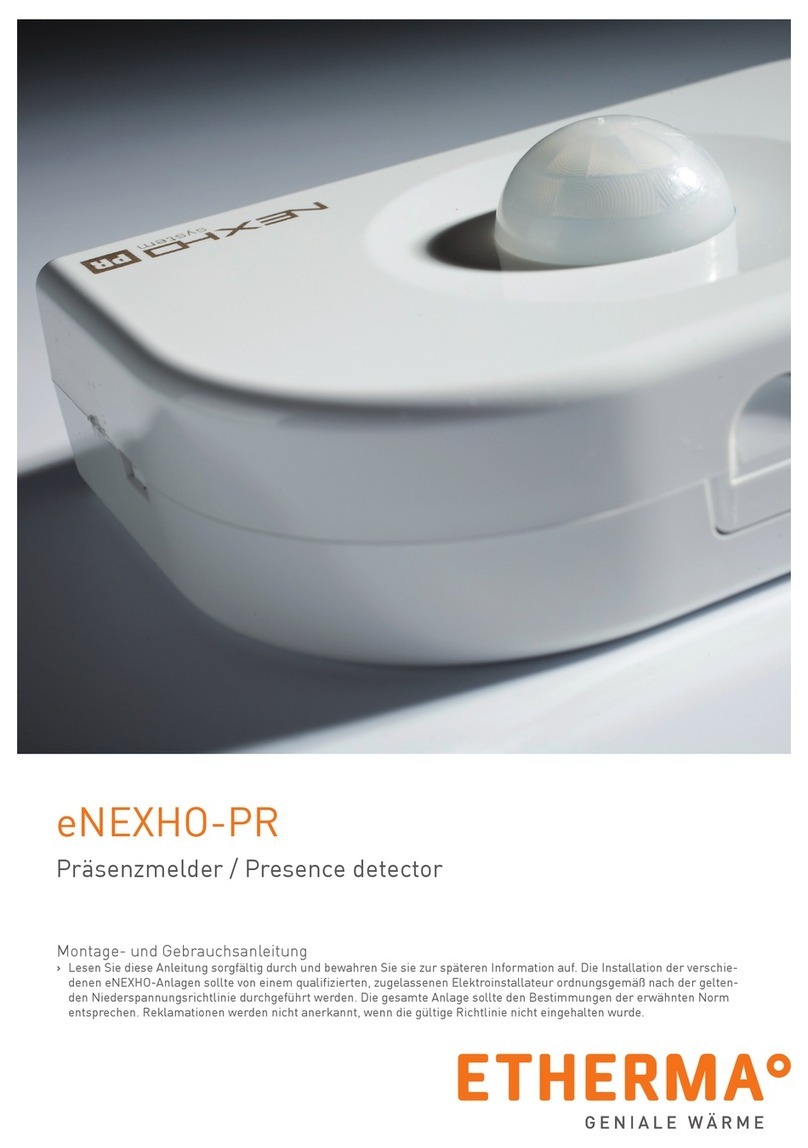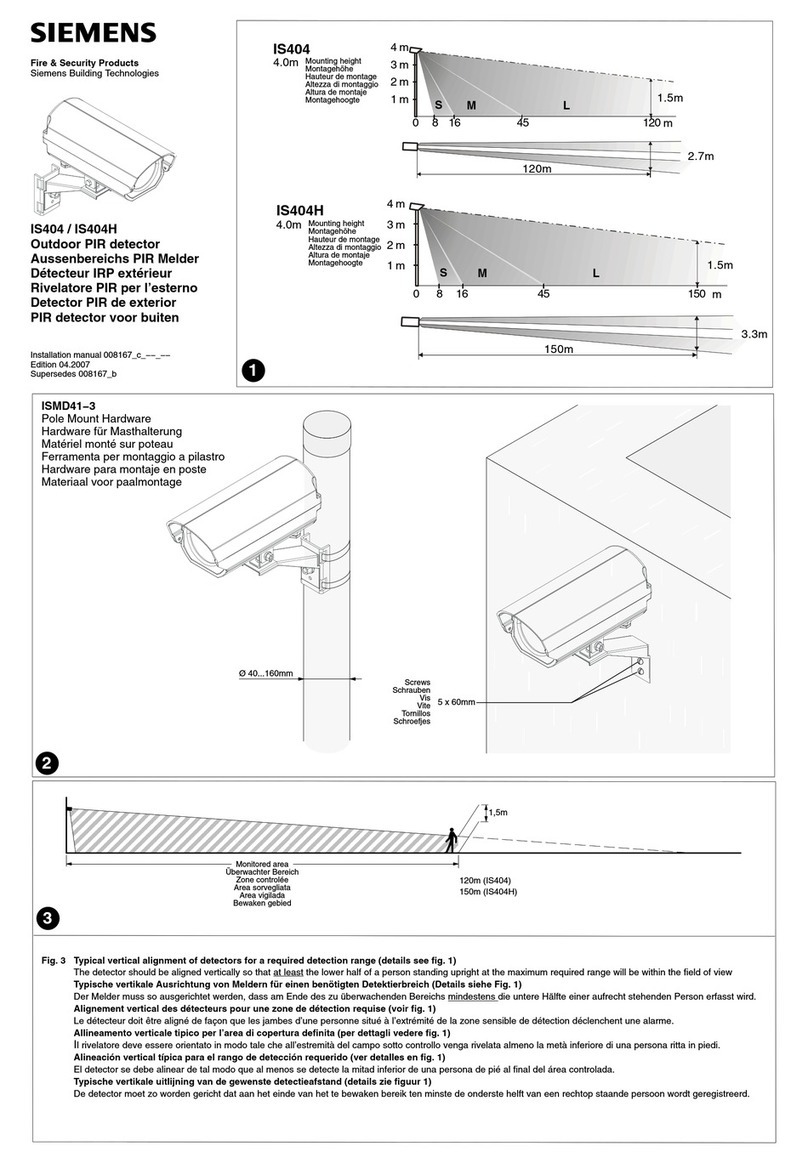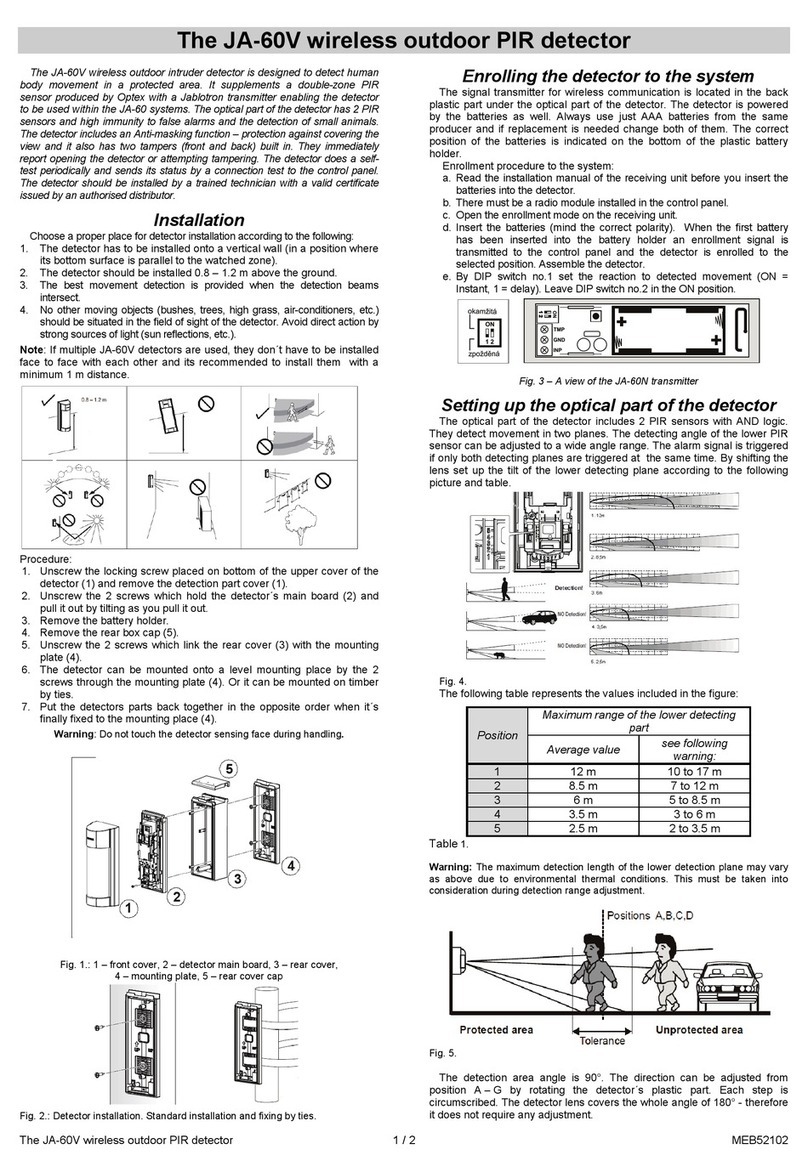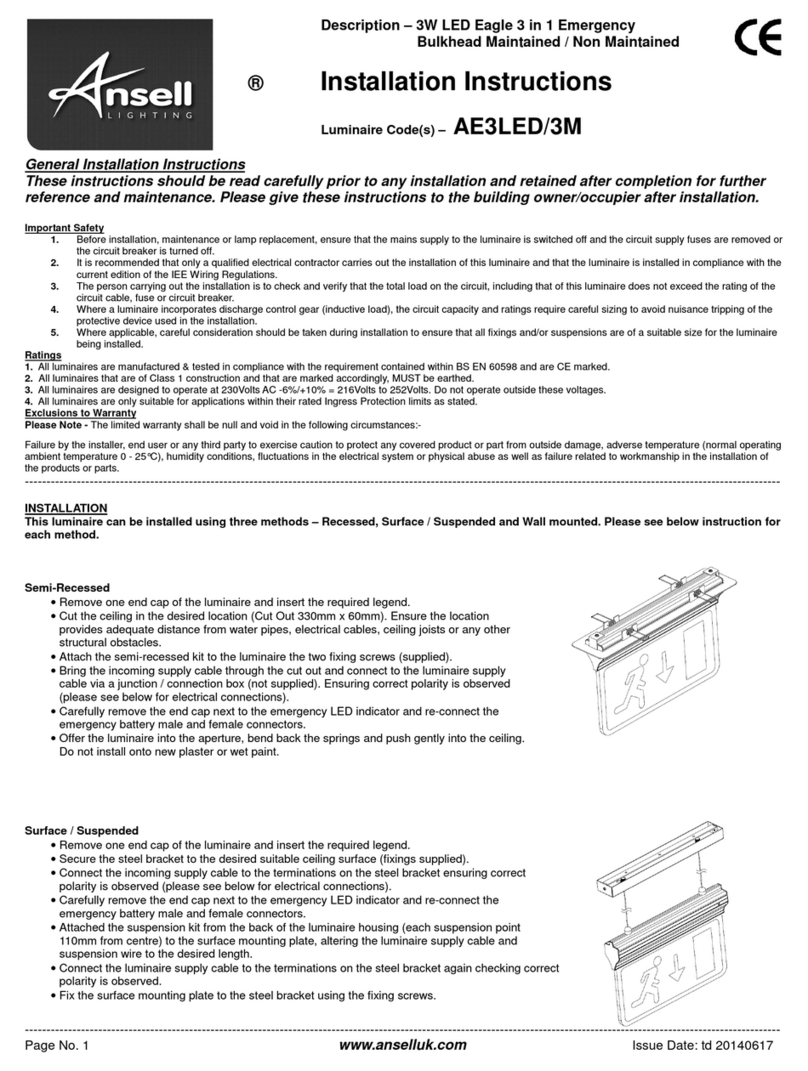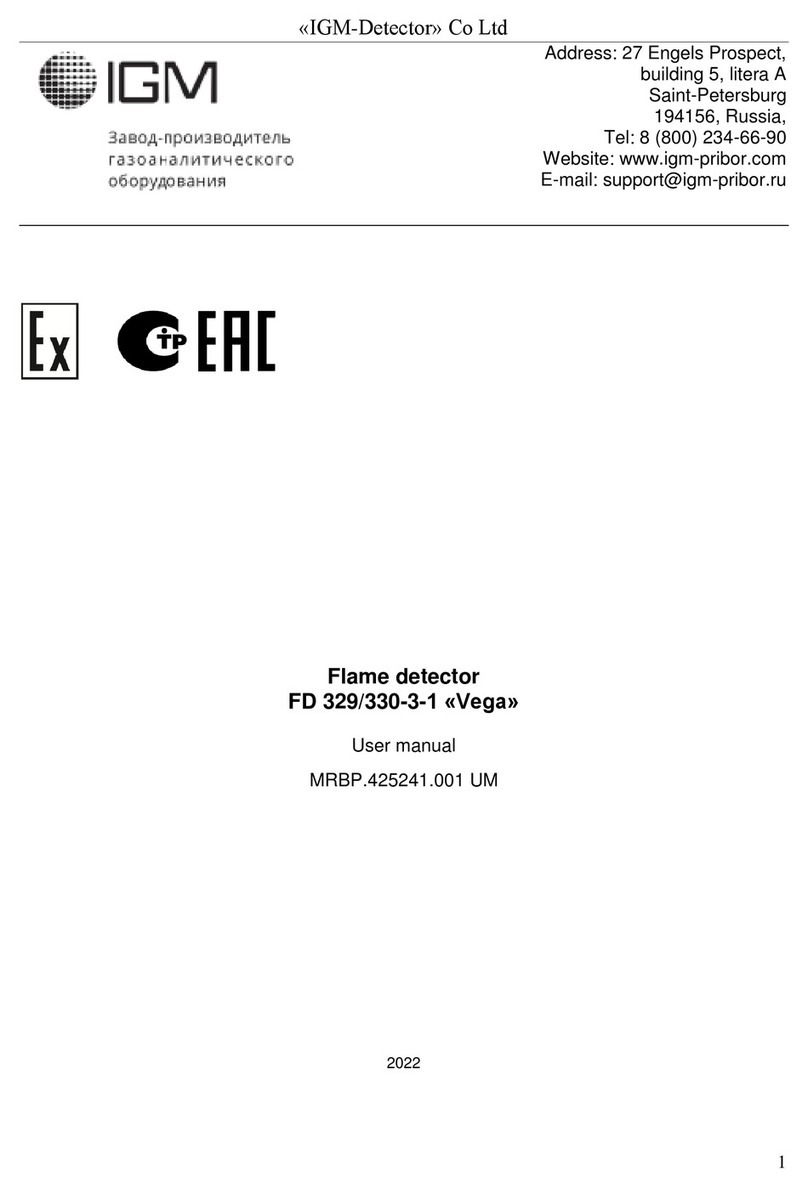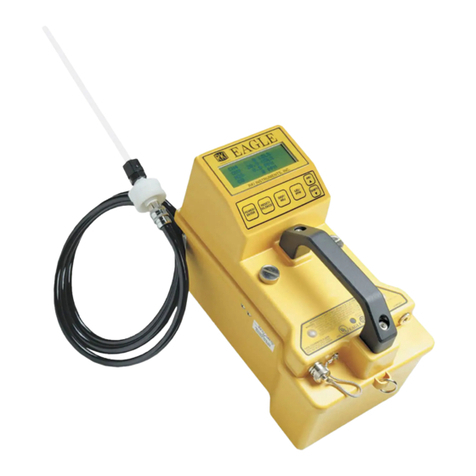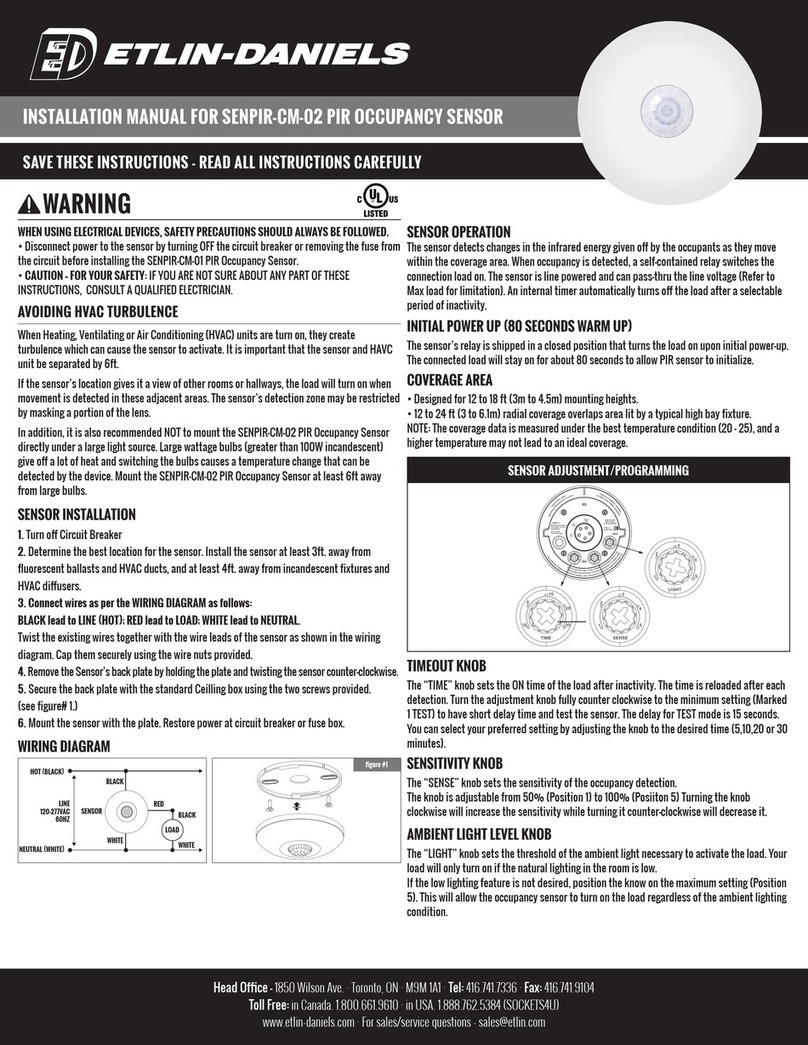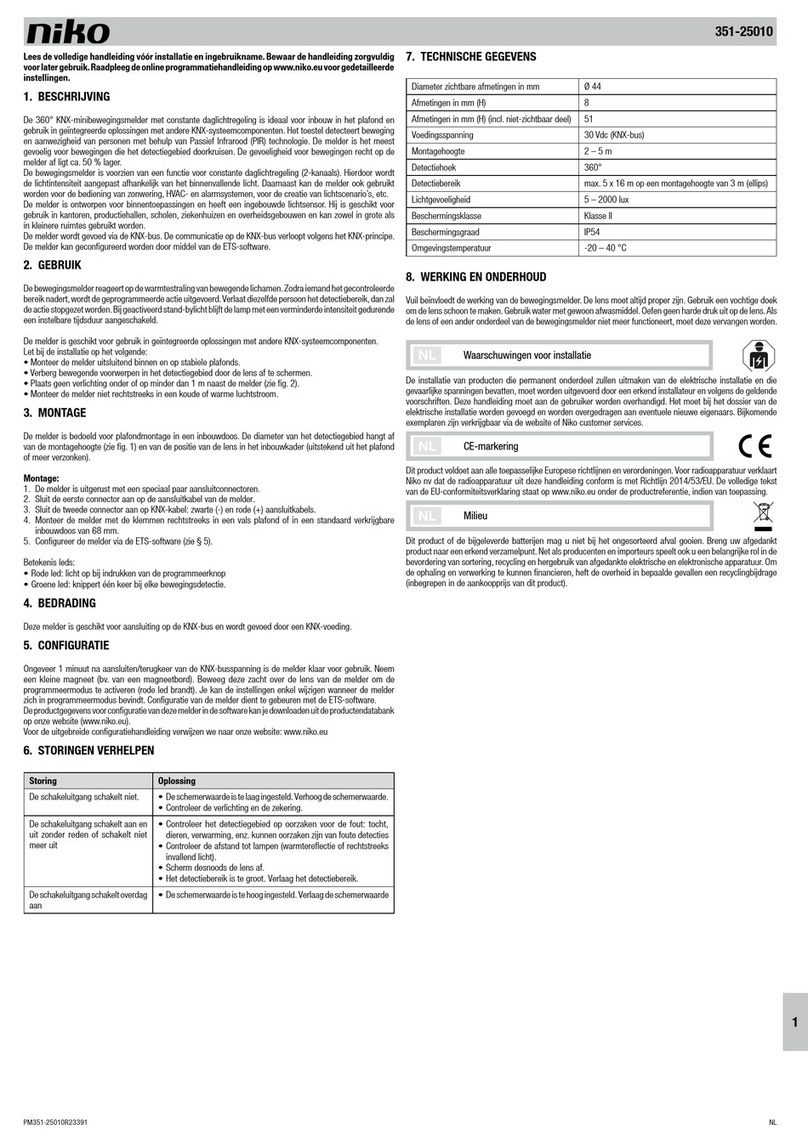Chemtronics 22 User manual

Manual
Version 2.0 dated 06.11.2012
Absorption Turbidity Sensor
Model 22 (CSW)
Chemtronic Waltemode GmbH.
40789 Monheim Niederstr. 14
Phone: +49-(0)2173-57007 Fax: +49-(0)2173-56007
Internet: www.chemtronic-gmbh.de

Chemtronic Waltemode GmbH, 40789 Monheim am Rhein, Niederstr. 14, Germany
Phone: +49-(0)2173-57007 Fax: +49-(0)2173-56007 Internet : www.chemtronic-gmbh.de E-mail: info@chemtronic-gmbh.de
Page 2
Content
Copyright ................................................................................................................................................. 3
Non-warranty........................................................................................................................................... 3
Warranty conditions................................................................................................................................. 3
Before installation and start-up................................................................................................................ 4
Installation guidelines.......................................................................................................................... 4
Safety instructions................................................................................................................................... 5
For ALL chemical liquids..................................................................................................................... 5
Electrical installation............................................................................................................................ 5
Maintenance........................................................................................................................................ 5
Storage.................................................................................................................................................... 6
Transport damage............................................................................................................................... 6
Shipment of the instrument................................................................................................................. 6
General.................................................................................................................................................... 7
What does Turbidity mean?................................................................................................................ 7
What Causes Turbidity?...................................................................................................................... 7
Turbidity Measurement ....................................................................................................................... 7
Principle of Absorbance Measurement............................................................................................... 7
Typical Turbidity Units............................................................................................................................. 8
The Dependencies on the Different Measurement Units.................................................................... 8
Concentration Measurement............................................................................................................... 8
Typical Ranges (depending by product).................................................................................................. 9
The absolute range of absorption sensors:......................................................................................... 9
Typical Applications................................................................................................................................. 9
Maintenance.......................................................................................................................................... 10
Replacement of measurement lamp................................................................................................. 10
Replacement of gaskets.................................................................................................................... 11
Replacement interval ........................................................................................................................ 11
Components Model 22 (CSW) .............................................................................................................. 12
Spare Part List Model 22 (CSW)........................................................................................................... 13
Wiring Diagram Model 22 (CSW) / Messenger (single Sensor)............................................................ 14
Wiring Diagram Model 22 (CSW) / Messenger (four Sensors)............................................................. 15
Wiring Diagram Model 22 (CSW) / CCAb ............................................................................................. 16
Dimensional Drawing Model 22 (CSW) DIN- Flange ............................................................................ 17
Dimensional Drawing Model 22 (CSW) ANSI- Flanges........................................................................ 18
Dimensional Drawing Model 22 (CSW) Milk Fittings............................................................................. 19
Dimensional Drawing Model 22 (CSW) TH- Flanges............................................................................ 20
Dimensional Drawing Model 22 (CSW) TH- Varivent Plates ................................................................ 21
Technical Data Model CSW (22)........................................................................................................... 22

Chemtronic Waltemode GmbH, 40789 Monheim am Rhein, Niederstr. 14, Germany
Phone: +49-(0)2173-57007 Fax: +49-(0)2173-56007 Internet : www.chemtronic-gmbh.de E-mail: info@chemtronic-gmbh.de
Page 3
Copyright
©2012 Chemtronic Waltemode GmbH
This manual including all of its parts are protected by copyright.
Any further use beyond the copyright laws is not allowed without the written approval
of Galvanic Applied Sciences.
There are no further reaching warranty claims to take because of the content of
existing document.
Non-warranty
Chemtronic Waltemode GmbH takes no responsibility or warranty for technical or
editorial mistakes or omissions in this document. The information in this publication
will be provided without warranty for their correctness.
Chemtronic Waltemode GmbH reserves all rights to make changes to this document
without announcement.
Chemtronic Waltemode GmbH is by no means liable for any consequential damages
or miscellaneous damages, which occur during the use or storage of the system.
Some countries do not allow the limitation of liability, so that this exclusion is possibly
not valid for you.
Warranty conditions
The warranty for this product takes place according to the legal provisions. As places
of warranty we explicitly name Chemtronic Waltemode GmbH, Niederstr. 14,
40789 Monheim am Rhein, Germany. In case of warranty service at the customer
site, we will charge additional expenses e.g. travel expenses, overnight cost, etc.
Consumable parts as well as wearing parts e.g. lamps, gaskets, etc. are not covered
by warranty. Improper use, gross negligence, use of the system outside of the
technical specifications, missing or improper maintenance will cause a loss of the
warranty claim. Please take notice to our general terms of contract.

Chemtronic Waltemode GmbH, 40789 Monheim am Rhein, Niederstr. 14, Germany
Phone: +49-(0)2173-57007 Fax: +49-(0)2173-56007 Internet : www.chemtronic-gmbh.de E-mail: info@chemtronic-gmbh.de
Page 4
Before installation and start-up
Installation guidelines
•The sensor is manufactured according to the customer’s application (variable line
size, flange type, cleaning jets, gasket material etc.).
•It is recommended to run the calibration of the system before installation of the
sensor.
•The location / installation of the sensor should be in a vertical standpipe.
•The process pressure should never exceed the specification of the delivered sensor.
•The process temperature should never exceed the specification of the delivered
sensor.
•Avoid air and gas bubbles inside the sensor, they cause disturbances. Air and gas
bubbles will cause noise and drift of the measurement signal. (The air bubbles are not
expected at pressures upwards of 2 bar in aqueous solutions).
•In case the process temperature should fall under the dew point or rise above 85 °C
purge the sensor optic housings with dry instrument air (approx. 10 l/h). Condensed
water and excessive temperatures can damage the sensor and cause inaccurate
measurements.
•Due to potential noise problems it is recommended not to extend the sensor cables.
•Due to potential noise problems use original parts only.
•In case the optional cleaning jets are being used, make sure the pressure of the
cleaning fluid is at least 50% higher than the process pressure.
Danger:
Exceeding the specified maximum pressure and /or the specified
maximum temperature will cause a very high safety risk.
Please read the additional safety instructions before installation and
start-up.

Chemtronic Waltemode GmbH, 40789 Monheim am Rhein, Niederstr. 14, Germany
Phone: +49-(0)2173-57007 Fax: +49-(0)2173-56007 Internet : www.chemtronic-gmbh.de E-mail: info@chemtronic-gmbh.de
Page 5
Safety instructions
Pay attention to the following general safety instructions during use and
operation of the system. Ignoring these instructions or special warnings inside
of this manual can damage the sensor, cause inaccurate measurements, and
possibly result in unsafe installations. Galvanic Applied Sciences will not take
any responsibility for consequences arising from ignoring the safety
instructions and warnings.
For ALL chemical liquids
The reagents or standards may be toxic or otherwise harmful to human
health. Observe appropriate precautions when handling and disposing the
reagents. Review the appropriate published material safety data sheets regarding the
safe handling and disposal of all reagents or standards.
Electrical installation
Qualified technical personnel must install the electrical installation of the system.
Hazardous area
DO NOT INSTALL the system in hazardous area without the optional Ex-proof
equipment.
Operation of non Ex- proof systems in hazardous area will cause a high risk.
Using the system in hazardous areas (Ex Zone I / Ex Zone II) will only
be safe with the installation of the optional special Ex-proof designs
including all required certifications.
Maintenance
Always disconnect the instrument from power during maintenance, replacement of
components, installation of additional components or any other operations at the
open instrument.
Only qualified technical personnel must perform this work.
Operating the instrument with open enclosure
Only qualified technical personnel should operate the instrument when the
enclosure is open (e.g. during calibration procedure). Be careful that no
moisture enters the enclosure.
Some components inside the instrument are energized with voltages, which
can cause lethal shocks in case of contact. Be careful during installation,
handling and operation of the instrument.
Improper installation / operation of the system
Warranty is void if the system is installed improperly, handled improperly, used
outside of the technical specifications (of the instrument), or damaged by gross
negligence.

Chemtronic Waltemode GmbH, 40789 Monheim am Rhein, Niederstr. 14, Germany
Phone: +49-(0)2173-57007 Fax: +49-(0)2173-56007 Internet : www.chemtronic-gmbh.de E-mail: info@chemtronic-gmbh.de
Page 6
Storage
Please inspect the instrument immediately after receiving for potential shipping
damages. In case the instrument has already been unpacked for inspection or
testing, or if the instrument has been removed from the process and it is not to be
installed or reinstalled for more than 1 day, the following procedure should be
observed:
1. If the instrument has been in service, the wetted portion should be thoroughly
cleaned (typically with clean water) and than thoroughly dried.
2. The instrument should be placed in the original packing material.
In case the original packing material is not available place the instrument in a
sealed heavy plastic bag with a desiccant added to assure clean dry storage.
3. The instrument should then be stored in a protected area until time of
installation.
Transport damage
Please inspect the instrument immediately after receiving for potential shipping
damages.
For any claims to the transportation insurance or warranty repair, it is absolutely
required to notify transportation damages immediately after receiving the instrument.
In case of obvious damages of the outer packaging, the carrier must give a receipt
for this damage to make demands for the insurance.
In case of a delayed announcement the insurance will not pay for damages and
Galvanic Applied Sciences will not assume liability for these damages.
Shipment of the instrument
Please clean the instrument carefully before shipment (e.g. for revision / repair).
Please use fixed packaging to protect the instrument against any shipping damages.
If at all possible the original packaging should be used.

Chemtronic Waltemode GmbH, 40789 Monheim am Rhein, Niederstr. 14, Germany
Phone: +49-(0)2173-57007 Fax: +49-(0)2173-56007 Internet : www.chemtronic-gmbh.de E-mail: info@chemtronic-gmbh.de
Page 7
General
What does Turbidity mean?
Turbidity is an optical impression, which describes the characteristic of a transparent
product, to scatter and absorb light. A focused light beam will be attenuated and
scattered in hazy products, so that this product can become practically opaque in
bigger layers.
What Causes Turbidity?
Turbidity is caused by particles in transparent products. A particle is defined as
something with a different refractive index as the carrier product. Some examples of
particles are, minerals, yeast cells , metals, oil drops in water, milk in water, gas
bubbles and aerosol’s.
Turbidity Measurement
Turbidity is not a clearly defined magnitude like e.g. temperature or pressure.
Turbidity is a subjective impression. For this reason turbidity measurement systems
will be typically calibrated by using a comparison's standard such as Formazin or
Diatomatious Earth.
Principle of Absorbance Measurement
A light source and a detector are located parallel over against. The changing of light intensity, caused
by the product between lamp and detector, will be detected and displayed as measuring result.
The application is the measurement of concentrations (color or solids) in a liquid.
The basic measurement unit of an absorption photometer, is called AU (Absorption -
Unit).
Definition of AU:
1 AU = 90 % loss of light intensity
2 AU = 99 % loss of light intensity
3 AU = 99,9 % loss of light intensity
4 AU = 99,99 % loss of light intensity
5 AU = 99,999 % loss of light intensity
Absorption diagram
0,001
0,01
0,1
1
10
100
012345
Absorption AU
Lichtintensität %

Chemtronic Waltemode GmbH, 40789 Monheim am Rhein, Niederstr. 14, Germany
Phone: +49-(0)2173-57007 Fax: +49-(0)2173-56007 Internet : www.chemtronic-gmbh.de E-mail: info@chemtronic-gmbh.de
Page 8
Typical Turbidity Units
ppm: Parts per million FNU1: Formacine nephelometric
unit
FTU: Formacine Turbidity Unit mg/l: Milligram per liter
TEF: Trübungseinheiten Formazin (German for
FTU) gr/l: Gram per liter
EBC: European brewery convention % TS: Percent total solids
NTU1: Nephelometric turbidity unit AU Absorption unit
The Dependencies on the Different Measurement Units
1 FTU = 1 TEF = 1 NTU1 = 1 FNU1 = 0,25 EBC
1 Nephelometry describes the method of side scattered turbidity measurement, these units are used at 90° side scattered
turbidimeter only.
Based on comparisons measurements, by using a 12° forward turbidity measurement
system we have found the following dependencies.
1 FTU = 1 TEF = 0,25 EBC = 2,05ppm = 2,05 mg/l = 0,00205 g/l = 0,00000205 % TS
* At a specific particle weight of 1kg/dm, 1mg/l particles in 1kg of water will correspond to 1ppm.
Concentration Measurement
The sensitivity of a turbidity measurement system, based on the principle of light
absorption, is mainly dependent by two parameters.
1. The intensity of the light source, which is typically constant.
2. The optical path length (OPL1)
The optical path length is variable and can be changed to match the
requirements of specific applications.
To measure low concentrations, a large OPL is required. Otherwise there is not
enough change in light intensity, to get good measurement results.
To measure high concentrations, a small OPL is required. Otherwise there is not
enough light energy, to pass the product.
Large OPL = Low concentrations / high sensitivity
Small OPL = High concentrations / low sensitivity
1OPL [= optical path length] specifies the product slot between light source and detector

Chemtronic Waltemode GmbH, 40789 Monheim am Rhein, Niederstr. 14, Germany
Phone: +49-(0)2173-57007 Fax: +49-(0)2173-56007 Internet : www.chemtronic-gmbh.de E-mail: info@chemtronic-gmbh.de
Page 9
Typical Ranges (depending by product)
OPL lowest range highest range
3 mm approx. 0 - 2 g/l approx. 0 - 100g/l (10% TS2)
50 mm approx. 0 - 200 mg/l approx. 0 - 6 g/l
The OPL has to be specified according to the conditions of customers application.
Construction of sensor’s, and various measurement windows, allows for OPL’s, between 1/10“ (2
mm)
up to 20“ (500 mm).
The absolute range of absorption sensors:
•0 to 0.1 AU (lowest range)
•0 to 5 AU (highest range).
Typical Applications
The absorption measurement is the most common method to measure turbidity. This
measurement method can be used in various applications, due to a large
measurement range, and many different shapes of sensors (immersion probes,
insertion probes, flow cells, etc.).
•Measurement of lauter wort in breweries
•Measurement of yeast concentration
•Dosage systems (Yeast / Diatomatious earth)
•Concentration measurement of various products
•Freight measurement systems (in combination with a flow meter)
•Centrifuge control
•Oil in water
•Water in oil
•Monitoring of coatings inside of pipe systems
•Sludge concentration
•Sludge level
•Measurements in flotation- / sedimentation tanks
•Pulp and paper
•Retention at paper machines
2% TS [= total solids]

Chemtronic Waltemode GmbH, 40789 Monheim am Rhein, Niederstr. 14, Germany
Phone: +49-(0)2173-57007 Fax: +49-(0)2173-56007 Internet : www.chemtronic-gmbh.de E-mail: info@chemtronic-gmbh.de
Page 10
Maintenance
Replacement of measurement lamp
Introduction
Ignoring of the following hints will cause a loss of warranty
Qualified technical personnel must perform repair and maintenance.
Before beginning any work the sensor must be cleaned and flushed thoroughly.
Depending on customers’ application product residues can be very dangerous
(aggressive, poisonous). Please handle the system very careful due to possible
leakage etc.
Avoid pulling and twisting of the lamp cable.
Avoid applying excessive force during assembling and disassembling of the sensor.
Screw in all bolts and cable glands stalwart only.
Please work carefully during the replacement of the measurement lamp.
The lamp replacement should be done in a dry and clean location, to protect the
optical components from dirt.
Please be sure that no dust or other particles penetrates into the optical assembly.
Do not touch the lenses.
In case of dirty component please clean carefully by using fresh water and a cloth
(lint-free), dry all components by using instrument air.
Use suitable tools only.

Chemtronic Waltemode GmbH, 40789 Monheim am Rhein, Niederstr. 14, Germany
Phone: +49-(0)2173-57007 Fax: +49-(0)2173-56007 Internet : www.chemtronic-gmbh.de E-mail: info@chemtronic-gmbh.de
Page 11
Replacement of gaskets
Introduction
Ignoring of the following hints will cause a loss of warranty
Qualified technical personnel must perform repair and maintenance.
Before beginning any work the sensor must be cleaned and flushed thoroughly.
Depending on customers’ application product residues can be very dangerous
(aggressive, poisonous). Please handle the system very carefully due to possible
leakage etc.
Avoid pulling and twisting of the lamp cable.
Avoid applying excessive force during assembling and disassembling of the sensor.
Screw in all bolts and cable glands stalwart only.
Please work carefully during the replacement of the measurement gaskets.
The gasket replacement should be done in a dry and clean location, to protect the
optical components from dirt.
Please be sure that no dust or other particles penetrates into the optical assembly.
Do not touch the lenses.
In case of any dirty component please clean carefully by using fresh water and a cloth
(lint-free), dry all components by using instrument air.
Use suitable tools only.
Replacement interval
The interval to replace the gaskets depends on the specific application.
The replacement cycle depends on process pressure, process temperature, sealing
material and product characteristics. In worst case (high temperature, high pressure
and aggressive medium) the gaskets must be replaced every month. Under normal
conditions the gaskets should be replaced every year. The maximum lifetime in easy
applications can go up to 2 years.
We strictly recommend that the customer establishes a maintenance interval based
on local conditions. In case of further questions, or if you require more information
please contact Chemtronic Waltemode GmbH.

Chemtronic Waltemode GmbH, 40789 Monheim am Rhein, Niederstr. 14, Germany
Phone: +49-(0)2173-57007 Fax: +49-(0)2173-56007 Internet : www.chemtronic-gmbh.de E-mail: info@chemtronic-gmbh.de
Page 12
Components Model 22 (CSW)

Chemtronic Waltemode GmbH, 40789 Monheim am Rhein, Niederstr. 14, Germany
Phone: +49-(0)2173-57007 Fax: +49-(0)2173-56007 Internet : www.chemtronic-gmbh.de E-mail: info@chemtronic-gmbh.de
Page 13
Spare Part List Model 22 (CSW)

Chemtronic Waltemode GmbH, 40789 Monheim am Rhein, Niederstr. 14, Germany
Phone: +49-(0)2173-57007 Fax: +49-(0)2173-56007 Internet : www.chemtronic-gmbh.de E-mail: info@chemtronic-gmbh.de
Page 14
Wiring Diagram Model 22 (CSW) / Messenger (single Sensor)

Chemtronic Waltemode GmbH, 40789 Monheim am Rhein, Niederstr. 14, Germany
Phone: +49-(0)2173-57007 Fax: +49-(0)2173-56007 Internet : www.chemtronic-gmbh.de E-mail: info@chemtronic-gmbh.de
Page 15
Wiring Diagram Model 22 (CSW) / Messenger (four Sensors)

Chemtronic Waltemode GmbH, 40789 Monheim am Rhein, Niederstr. 14, Germany
Phone: +49-(0)2173-57007 Fax: +49-(0)2173-56007 Internet : www.chemtronic-gmbh.de E-mail: info@chemtronic-gmbh.de
Page 16
Wiring Diagram Model 22 (CSW) / CCAb

Chemtronic Waltemode GmbH, 40789 Monheim am Rhein, Niederstr. 14, Germany
Phone: +49-(0)2173-57007 Fax: +49-(0)2173-56007 Internet : www.chemtronic-gmbh.de E-mail: info@chemtronic-gmbh.de
Page 17
Dimensional Drawing Model 22 (CSW) DIN- Flange

Chemtronic Waltemode GmbH, 40789 Monheim am Rhein, Niederstr. 14, Germany
Phone: +49-(0)2173-57007 Fax: +49-(0)2173-56007 Internet : www.chemtronic-gmbh.de E-mail: info@chemtronic-gmbh.de
Page 18
Dimensional Drawing Model 22 (CSW) ANSI- Flanges

Chemtronic Waltemode GmbH, 40789 Monheim am Rhein, Niederstr. 14, Germany
Phone: +49-(0)2173-57007 Fax: +49-(0)2173-56007 Internet : www.chemtronic-gmbh.de E-mail: info@chemtronic-gmbh.de
Page 19
Dimensional Drawing Model 22 (CSW) Milk Fittings

Chemtronic Waltemode GmbH, 40789 Monheim am Rhein, Niederstr. 14, Germany
Phone: +49-(0)2173-57007 Fax: +49-(0)2173-56007 Internet : www.chemtronic-gmbh.de E-mail: info@chemtronic-gmbh.de
Page 20
Dimensional Drawing Model 22 (CSW) TH- Flanges
This manual suits for next models
1
Table of contents
Other Chemtronics Security Sensor manuals
Popular Security Sensor manuals by other brands
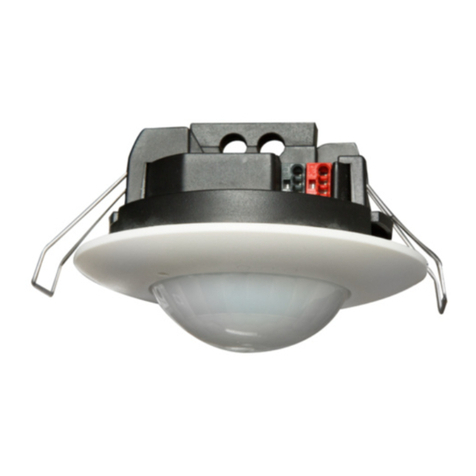
B.E.G. LUXOMAT
B.E.G. LUXOMAT PD2N-KNX-ST-FT Mounting instructions
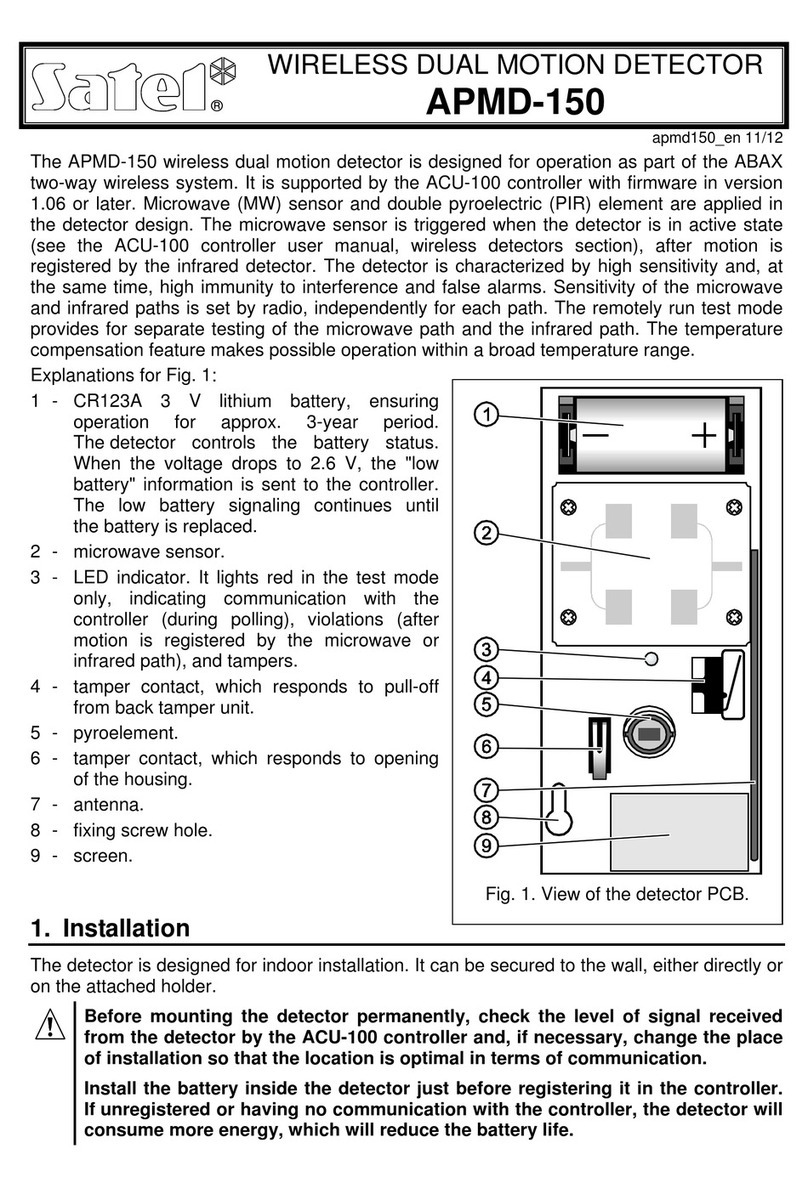
Satel
Satel APMD-150 manual
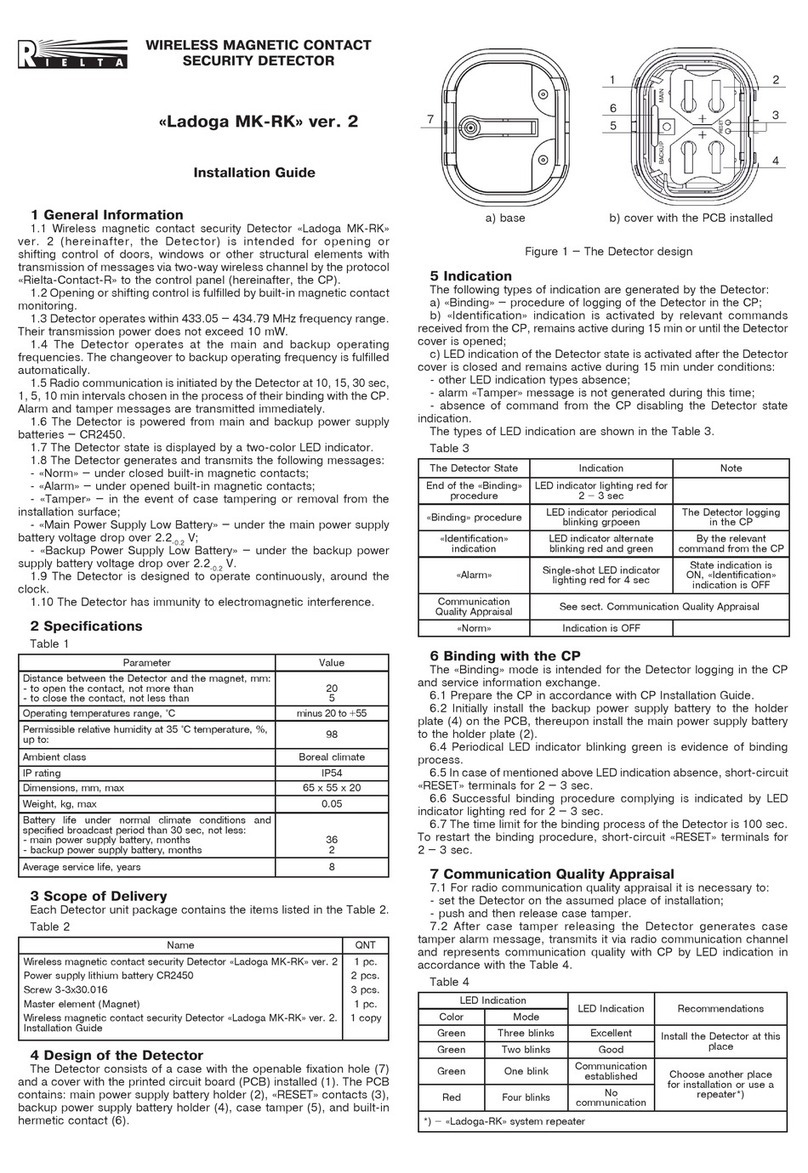
Rielta
Rielta Ladoga MK-RK installation guide

ITALIANA SENSORI
ITALIANA SENSORI 8058-ISR044 Installation, operation and maintenance manual
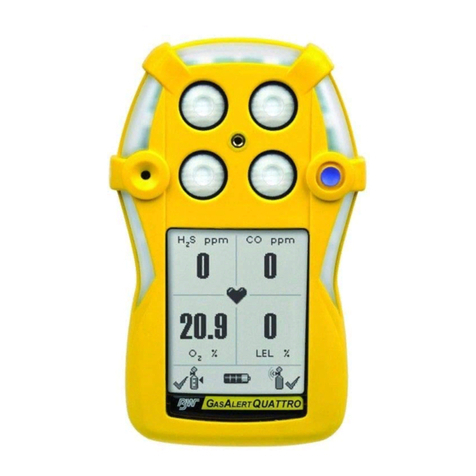
BW
BW GasAlert Quattro user manual

JFL Alarmes
JFL Alarmes IRA-360 user manual

